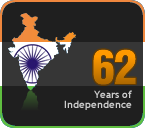- Call for action on the Millennium Development Goals
- Focus the attention of India's young adults on concerns that impact their future
The background to a unique initiative
Unnati Features and Women's Feature Service are together anchoring an innovatively designed public service initiative that links people, especially the youth, to policy makers and civil society leaders. It is being supported by the UN Millennium Campaign.
The initiative is entitled
MERA INDIA, BRIDGE THE GAP
Millennium Development Goals: How should we deliver on these promises?
According to its MDGs commitments, India must reduce by 2015 the proportion of people below the poverty line -- from nearly 37.5 per cent in 1990 to about 18.75 per cent in 2015. It must bring down its under-five mortality - which stood at 60 per 1000 live births in 2003 - to 42 per 1000 live births by 2015. Access to water is another major challenge. India needs to halve the proportion of population without sustainable access to safe drinking water and sanitation by 2015, even as independent estimations project that the per capita availability of water may actually decline in the country as the years go by. The problems of urban India are a huge area of concern as well. An estimated 40 per cent of India's population will be located in urban areas by the year 2020, with at least 15 per cent of them expected to be living in slums and shanties where the quality of life is abysmal.
With just six years to go, relevant and targeted action to achieve the MDGs is the need of the hour. It is in that context that the ‘Mera India: Bridge the Gap’ Contest asks young Indians how the country should deliver on its promises on MDGs.
How does it work?
The MERA INDIA, BRIDGE THE GAP initiative is to be conducted in two phases.
The first phase entails the holding of a nation-wide contest for participants in the 18 to 35 year age group.
Each entrant will rank the following constituents on a scale of 10 to 1, in order of importance for the achievement of MDGs. Higher points go to the constituent considered more important.
The constituents –
1. Celebrities
2. Corporate leaders
3. Educationists
4. Elected representatives
5. Government officials
6. Health personnel
7. NGOs
8. The Judiciary
9. The Media
10. The Youth
The entrant will then state what the most important things that need to be done are to achieve the MDGs, choosing from the following formats :
A 1000-word essay, or a pictorial strip, or a film made with the mobile phone or digital camera, not longer than five minutes.
The selection of award winners
Each entry would be judged on its content, its innovative nature and the practicability of the ideas suggested. An elimination round would be done in-house. A panel of independent persons well known in their respective fields will conduct the final selection.
There are the following prizes for the winners -
1st prize – Rs 75,000
2nd prize – Rs 50,000
3rd prize – Rs 25,000
And many other prizes too!
The awards will be handed over to the winners at a special function to be held in New Delhi, where the winning entries will be suitably showcased.
The second phase would focus on publicising the award-winning entries by reaching out to a broad swathe of society -- including the newly-elected representatives, NGOs working in the field of governance, women’s groups and groups working on caste and empowerment issues as well as the media. Special importance would be given to the constituents the youth have highlighted as most important in achieving the MDGs.
CALL FOR ACTION ON MDGs!
CALL FOR VISIBLE CHANGE IN PEOPLE’S LIVES !
CALL FOR VISIBLE CHANGE IN PEOPLE’S LIVES !











No comments:
Post a Comment